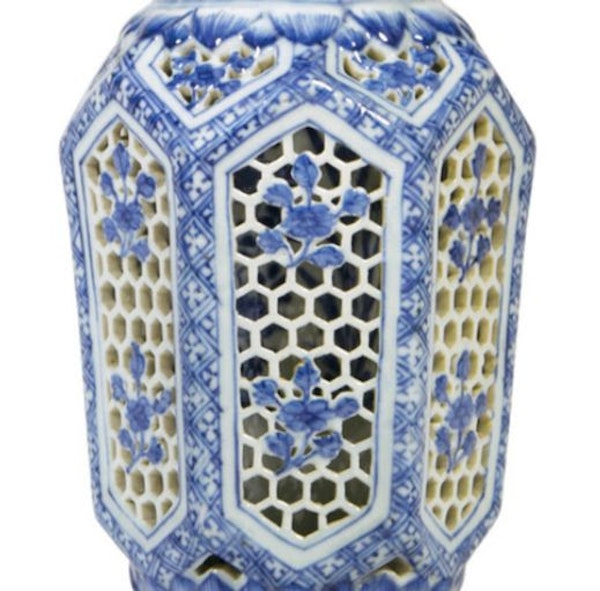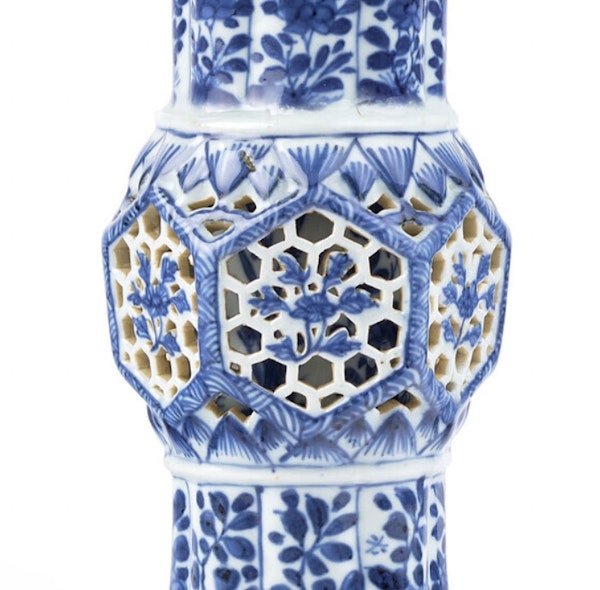Three Rare Chinese Blue and White Double Walled Reticulated Vases
Three Rare Chinese Blue and White Double Walled Reticulated Vases
POA
Description
Comprising: one trumpet vase, two hexagonal vases and covers. Each decorated in bright shades of underglaze blue and with reticulated mid-section, the hexagonal vases raised on a circular spreading foot with moulded lotus petals, the elongated hexagonal reticulated panels with reserved floral sprays, further raised lotus petals to the shoulder and neck, the domed cover with moulded lotus petals and lotus bud finial; the trumpet vase with tall spreading foot with moulded lotus petal panels decorated with floral sprays, the pattern repeated to the tall everted neck, the wide hexagonal reticulated panels with reserved floral sprays, pendant lotus petals around the shoulder, the bases glazed.
Period: Kangxi (1662 – 1722)
Footnote:
Reticulated porcelain, is characterised by intricate cuts creating a pierced pattern. Père Francois Xavier d`Entrecolles (1664-1741) used the term reticulated in the 18th century to describe porcelain that had the appearance of a net. An alternative term for this type of porcelain is 'Devils Work', or Guigong. The Chinese term 'Linglong' is also used, which refers to something that is exquisite and elegant.
The Kangxi period was known as the ‘age of innovation’. Reticulated decoration was combined with other innovations of the era. Examples of double-walled reticulated porcelain from this time, such as double-walled reticulated bowls and teapots are known but vases are more rare. A rare double-walled reticulated hookah base was held at Schloss Trachenberg, Silesia.
Openwork patterns can be found as early as the Shang Dynasty, where it appears on bronze wares, which are in some instances double-walled, with a closed inner and pierced outer wall.
In porcelain The National Palace Museum, Taipei, holds three related reticulated vases. The ceramic vessels have pierced walls, and an inner closed hull so they could be used. These were made by the official (guan) kilns of Laohudong in the Song dynasty (960-1279), see, (Du Zhengxian, ed., Hangzhou Laohudong yaozhi ciqi jingxuan [Selection of porcelains from the Laohudong kiln sites in Hangzhou], Beijing, 2002, pls 24 and 25).
In the Ming we find double-walled work in favour on fahua ware see one illustrated in: Idemitsu Bijutsukan zhin zuroku. Chugoku toji / Chinese Ceramics in the Idemitsu Collection, Vol. 3, Tokyo, 1987, no. 683.
This innovation and technical sophistication continued into the Qing period, in the Kangxi period with objects like our vases and then incredibly intricate Imperial vases were made for the Qianlong Emperor presenting the imperial kilns with their greatest ever challenge.
The technique of piercing the walls of a vessel to create an delicate openwork design was known by the Chinese as ling long or 'delicate openwork’, The openwork designs were cut by hand when the clay was 'leather hard'. Both the cutting and subsequent firing would have required great skill. During the Wanli period this technique is found on fully reticulated bowls, see ones illustrated by M. Medley in Illustrated Catalogue of Underglaze Blue and Copper Red Decorated Porcelains in the Percival David Foundation of Chinese Art, London, 1976, plate XI, nos. B620 and B623, listed p. 57, and Chen Runmin, Selected Chinese Ceramics from the Palace Museum (Volume 1): Blue and White Ceramics in Shunzhi and Kangxi Periods (Qing Shunzhi Kangxi chao qing hua ci), Beijing, 2005, p. 203, no. 124. The workmanship on the present vases is slightly more involved, as they have an inner wall, and the openwork only goes through the outer wall.
| item details | |
|---|---|
| Origin | Chinese |
| Period | 18th Century |
| Dimensions | Height: 24.2 cm (9 1⁄2 in.) and 27 cm (10 5⁄8 in.) |
Product REF: BH73






